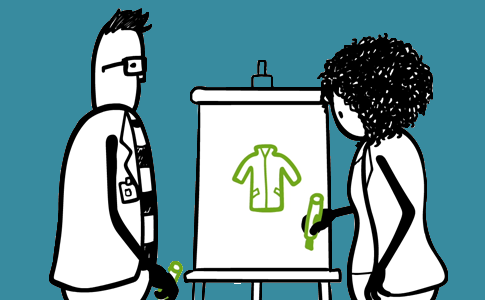How Do You Solve a Problem like Microfiber Pollution?
It’s often the case with big, woolly environmental problems that the first solutions to emerge are technical quick fixes or individual ‘consumer’ interventions, rather than systemic interventions. It’s easier to change a lightbulb than to build a sustainable energy system! Microfiber pollution is no different.
On our Facebook posts for the past several weeks, Story of Stuff Community members have asked “what can I do?” Is the solution to stop wearing and dispose of my polyester clothes? Wear clothing made from cotton, hemp or other natural fibers? Wash less? Others have asked about washing machine filters or suggested the Guppy Friend, a mesh bag created by a German duo that purports to capture fibers from the clothes washed in them.
What’s great about these questions—beyond their expressions of heartfelt desire to do the right thing—is that they offer an opportunity to think about both where the best place to intervene is and who has responsibility for that intervention.
So yes, we could choose to wear only natural fabrics—cotton, wool, hemp—but the fact is more than 60% of clothing includes synthetic fabrics, and that market share is growing fast. Unless you convince everyone to wear natural fabrics you’re unlikely to solve the problem, even if your individual share is reduced to zero.
And yes, we do encourage folks to avoid synthetics when they’re not absolutely necessary—a trip to the grocery store probably doesn’t require technical clothing designed for summiting Everest. You can also wash synthetics less, or wash them in a mesh bag designed to trap microfibers, like the Guppy Friend. Indeed, we’re encouraged by the number of designers thinking through filters or detergents or other interventions that could mitigate the problem.
But again, these interventions require universal adoption to work and, at least in the case of the mesh bag, individual consumers are currently required to pay extra to keep plastic from washing down their drain.
As our founder Annie Leonard puts it, when it’s hard to figure out how to fix a problem on your own, or the fix is onerous or expensive, that should serve as a sort of metal detector for flaws in the system; it should encourage us to look further upstream for a solution.
Presently, those proposed solutions fall into three buckets:
First, some have proposed built-in washing machine filters—adopted universally on a volunteer basis or by law—that would capture fibers during the wash, similar to a lint filter in a drying machine. Washing machine manufacturers have expressed both technical and political concerns about these proposals: whether filters fine enough to capture fibers would be able to efficiently process wastewater and, more to the point, whether they should be financially responsible for fixing the problem in the first place. We think they’ve got a point, but let’s encourage them to keep exploring!
Others have proposed upgrading wastewater treatment facilities, most of which are currently unable to filter out all microplastics, including microfibers, prior to releasing water back into the environment. This would of course be a massive technical and financial undertaking by a group of mainly publicly-funded, local agencies. Beyond the significant design challenges—including what to do with the plastic-flecked waste sludge, which is often land-applied as fertilizer—one has to ask, would taxpayers foot the bill for such upgrades? Or, would we hold clothing brands responsible through some sort of tax or fee? Again, it’s hard to see this happening, but we know from the successful effort to ban plastic microbeads that wastewater agencies share our concerns and want to be part of a solution. That’s a good thing!
Finally, there are the clothing companies themselves. Ultimately, we believe producers have the main responsibility to deal with their products’ impacts. Some companies have already begun to look at things like alternative material designs or fabric coatings. That’s great, and we’re excited about the potential for durable, healthy and non-polluting fabrics.
Unfortunately, far too many clothing companies have their heads stuck in the sand. Even though we’ve known about microfiber pollution for at least five years, some haven’t even publicly admitted that their products pollute. And that’s where we’re focusing our energy: turning up the volume on this issue, expanding public understanding and creating a chorus of voices demanding accountability and transparency.
We’ve called on clothing brands to publicly acknowledge the seriousness of the pollution threat that microfibers pose, commit to investments of time and resources to investigate and test potential solutions and share what they learn with each other and the public.
We hope you’ll join that call by signing our petition, which we’ll deliver to the largest clothing brands in the world.
Solutions to this unique pollution challenge are difficult, and they’ll require cooperation between clothing brands, advocates, scientists, designers, and others. But there is also an urgency we can’t and won’t ignore.
We’ve got our work cut out for us so let’s get to it.
- Watch The Story of Microfibers!
- Join us in demanding that clothing companies take responsibility for microfiber pollution!
- Donate to help us stop plastic pollution!






